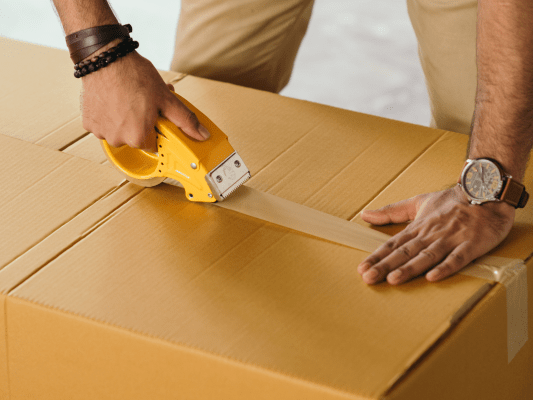Amazon FBA can be a fantastic way of managing your online arbitrage inventory. While there are costs associated, the amount of weight it takes off your shoulders as someone who should be spending their time sourcing products is incredible, and it’s for this reason that many online arbitrageurs exclusively use FBA as a fulfilment method for the products they sell.

However, shipping to Amazon can be a little bit of a touchy subject, and as such in this article we’re going to show you what to do (and what not to do) in order to get your items shipped to Amazon as safely and as quickly as possible.
Why use FBA?
There are a number of reasons you should use FBA when considering the fulfilment of your online arbitrage items. The main benefit of FBA, of course, is that Amazon allows you to delegate the picking, packing and shipping of your items to them. They also handle customer enquiries for you. This way, you never have to worry about logistics and you can focus on what you do best – sourcing products for your online arbitrage business.
Items fulfilled via FBA automatically get the Prime badge and are eligible for Prime shipping. FBA items also get preferential treatment when it comes to the buy box, alongside unlimited storage space in their warehouses as well as multi-channel fulfilment – you can even have items sold on eBay shipped via Amazon FBA!
There are a number of drawbacks, but the advantages of FBA are pretty compelling and it’s the reason many online arbitrageurs choose to use FBA as their fulfilment method. But how do you get products to Amazon? In this article we teach you everything you need to know about shipping your items to Amazon FBA.
How to get your products to Amazon FBA
Amazon makes this very easy now using the “Send to Amazon” workflow. Go into Seller Central and click “Manage all Inventory”.
Click “Send/Replenish Inventory.”
Enter your product’s details – the quantity per box, dimensions and package weight. It’s important to get these right as there have been instances of Amazon refusing a shipment that is over or underweight or not at the size described.
Now, tell Amazon how many units you will be sending.
Confirm your shipping information and agree to the charges. You can choose your ship date, the mode (less than truckload or small parcel) and confirm the carrier. Now, you simply print your labels out and ship your items to Amazon.
One thing you need to watch out for (and one we discuss in great detail below) is that Amazon is very strict in terms of what they will accept delivery of into one of their fulfilment centers. As such, we’d highly recommend the use of an FBA prep service.
Why use an FBA prep service?
Simply, because it’s far easier and quicker to have someone else manage the shipping to Amazon than it is to do it yourself, especially if you’re dealing with a significant quantity of items. As we go into below, Amazon can refuse shipments for a variety of reasons, and it may be that you incur significant costs to get your items back to you if Amazon has refused them. A prep service removes this worry – you can almost guarantee the items will be accepted providing you use a prep service with a good track record. Simply ship your items to the prep service and they handle the rest.
We’ve written a more in-depth article on using an FBA prep service, which you can check out if you’re interested in using one for your FBA shipments.
Potentially costly mistakes of shipping to Amazon FBA yourself
Shipping to Amazon FBA can be a bit of a minefield – there are a lot of things that can go wrong and Amazon isn’t always 100% transparent with their policies. Doing things incorrectly can lead to your shipments being refused, fees being levied or even disposal of your goods. This is why it’s important that you are either very clued up on Amazon’s policies, or you outsource the shipping to a third party FBA prep service.
Amazon can be really strict with their policies and there are stories of items being refused more than once for tiny infractions. This is one of the more frustrating experiences for an Amazon seller and therefore it’s crucial that you get this right. A few of the pitfalls that many new sellers fall into can include:
Not using an approved carrier
Amazon has a series of partnered carriers that they will allow to deliver to their fulfilment centers. If you try to get an item delivered by a non-approved carrier, the shipment will simply be refused and the delivery driver will be turned away. Amazon often requires carriers to adhere to specific appointment times, so a non-approved carrier arriving at an Amazon FC without an appointment to deliver your goods will result in the goods being returned to you at your expense.
Shipping directly from suppliers
Many new online arbitrageurs think that a very simple way of taking advantage of discounts is having them shipped directly to an Amazon warehouse. This saves on your own shipping costs, as many retailers offer free delivery.
However, it’s not this simple. Firstly, many retailers will actually refuse to deliver items to an Amazon fulfilment center. Coupled with the fact that you have no control over the carrier (which can lead to items being refused as we discussed), the retailer will not be able to affix the correct Amazon shipping label, complete with your unique FNSKU, so even if Amazon did accept the delivery they have no idea that the shipment belongs to you.
However – for wholesale sellers sourcing from overseas, there is now a programme called Amazon Global Logistics that will allow you to book in overseas shipments without them having to go to a prep center first. This isn’t relevant for retail arbitrage – for example, if you ordered 10 tables from Walmart and tried to have them delivered to Amazon, it’s likely they wouldn’t even get shipped out but even if they did, Amazon would refuse them.
Shipping damaged items
Incorrectly packed or damaged items are one of the main reasons for Amazon refusing delivery of FBA items. If an item is identified as damaged upon delivery to Amazon, they will refuse delivery of the item and it will be sent back to you.
Shipping to the incorrect warehouse
If the FBA warehouse you have shipped to is different from the one Amazon told you to ship to, they will refuse the delivery. You may even need to find another carrier to help you get your products back. If you use an FBA prep service this is something you need to get right, as delays due to shipment arriving in the wrong place can be costly.
Incorrect FBA shipping label or FNSKU
If the shipping label or FNSKU is incorrect, Amazon will reject your items. If Amazon does not spot a mistake, and a customer gets the incorrect item due to the fact that you mislabelled it, Amazon may even suspend your listings, so this is crucial to get right.
Individual boxes must have their own shipping label, and each unit needs its own unique barcode, all of which you can get through your Seller account. Make sure you (or your FBA prep centre) label your products accurately to avoid problems further down the line.
Other reasons Amazon might reject a shipment
Other than the reasons above, Amazon also refuses shipments for two main reasons – the shipment arrived outside of an allowable period (effectively, the shipment arrived late) or that you have outstanding duties or fees.
Duties or fees aren’t really relevant for online arbitrage as you’ll be shipping items domestically, but if you are a wholesaler using the Global Logistics programme, you may find that goods over the value of $800 (in the USA) are rejected as Amazon won’t pay your import taxes for you. In this case you’ll probably want to use a prep center, or ask your supplier to break the shipments down into smaller boxes so each one is below this threshold (known as the de minimis threshold.) Or, if using UPS/FedEx, you can have the items delivered DDP (meaning that the delivery duty has already been paid by the seller and there are no duties to pay.)
By far the most common reason for rejections is that your shipment arrived outside the designated window. Amazon gives you 90 days to ship an item to them. If you fail to meet their shipping deadline, Amazon will refuse your item upon delivery. Thankfully, this is quite easy to comply with from an online arbitrage perspective, as it’s unlikely the shipment process from retailer to prep center to Amazon is going to take any longer than a few weeks in even the most extreme scenario. However, if you do go over the 90 day limit, just be aware that Amazon will refuse your item for being late.
There may be other requirements on a per-parcel basis, such as weight limits – so ensure you check your Seller dashboard for all information before you commit to shipping your items out.
What happens if Amazon rejects a shipment?
Generally, the carrier should return it to you. Firstly, you may not get anything from Amazon themselves – the carrier should update their tracking information to say that the shipment was refused. In some cases this may even not be anything to do with you – perhaps the carrier showed up late to their appointment at Amazon and therefore the delivery was not accepted. In this case, you’ll have to seek redress from the carrier.
Amazon should give the driver a signed document which details the reason for the rejection, and you should request this from the carrier. With this document, you can then email the Amazon refusals team and ask for a detailed explanation. You’ll be told exactly why your shipment was rejected and how you can rectify it next time.
Frequently asked questions
Do you need custom packaging for Amazon FBA?
No, you don’t need custom packaging. When an order comes in, Amazon will pick, pack and ship your item out in branded Amazon packaging.
Can I drop off items to a fulfilment center?
Amazon does not allow sellers to manually drop off items at a fulfilment center. You must use an approved carrier and have them pick up from your home or from your FBA prep center. As frustrating as this might be if you live close to an FC and could deliver your items there by yourself in far less time than a courier could, if you show up at an Amazon facility with your products, they will not be accepted.
How many products can I ship to Amazon FBA at a time?
This really depends on your seller status and the item you are trying to ship to Amazon. When you create a shipping plan in Seller Central, Amazon will tell you how many items you can ship to them, also taking into consideration your quantity limits. Do not exceed what Amazon tells you, as this could lead to your shipment being refused, or even if it is accepted, you may be liable to pay overage charges.
Do you need to use Amazon FBA?
Absolutely not – you’re just as likely to succeed at online arbitrage by using FBM (fulfilled by merchant) instead of FBA (fulfilled by Amazon). However, you should bear in mind that once your arbitrage business gets big enough, you may struggle to store all your items at home. Additionally, if you see a good deal on a bulky item, you should buy as many as possible to ensure maximum profit but if you don’t have anywhere to store them, you might find that this becomes a problem quite quickly. Therefore, many online arbitrageurs prefer to ship items to Amazon and allow them to handle the storage and shipment of your stock through FBA.
Do I need to use a prep center for FBA?
You don’t need to, but we’d highly recommend it. Amazon’s shipping policies can be very extensive and as mentioned, sometimes they aren’t particularly transparent. An FBA prep service is paid a small percentage per unit to ensure that you comply with these policies and your items get accepted by Amazon. You don’t have to do this, but you do run the risk of Amazon rejecting your items if you don’t get everything exactly right.
In conclusion
It’s not necessary to use Amazon FBA as a fulfillment method when doing online arbitrage, but it’s one of the more popular ways of doing it and something you should definitely consider. Something else you should consider is a product sourcing tool like SourceMogul, which will spot online arbitrage opportunities for you without you having to manually research retailer’s websites and see how much profit you might make. SourceMogul scans millions of products at thousands of retailers, showing you the most profitable products to resell on Amazon after fees and taxes.
We offer a 7 day free trial of SourceMogul, which you can access using the link below.
More strategy
-

6 steps to becoming an Amazon seller. No experience needed.
Becoming a successful Amazon seller is easy - the Amazon brand and logo represents…
-

Top tips for success from a new Amazon seller
We've compiled a list of the top tips for new sellers, gathered from a…
-

How to get ungated on Amazon – your guide to Amazon restricted categories
If you’re looking to expand your online arbitrage business, you might find yourself tempted…
-

How to prepare for Amazon Q4 trading
Every year the holiday season seems to come around a little earlier. As an…




